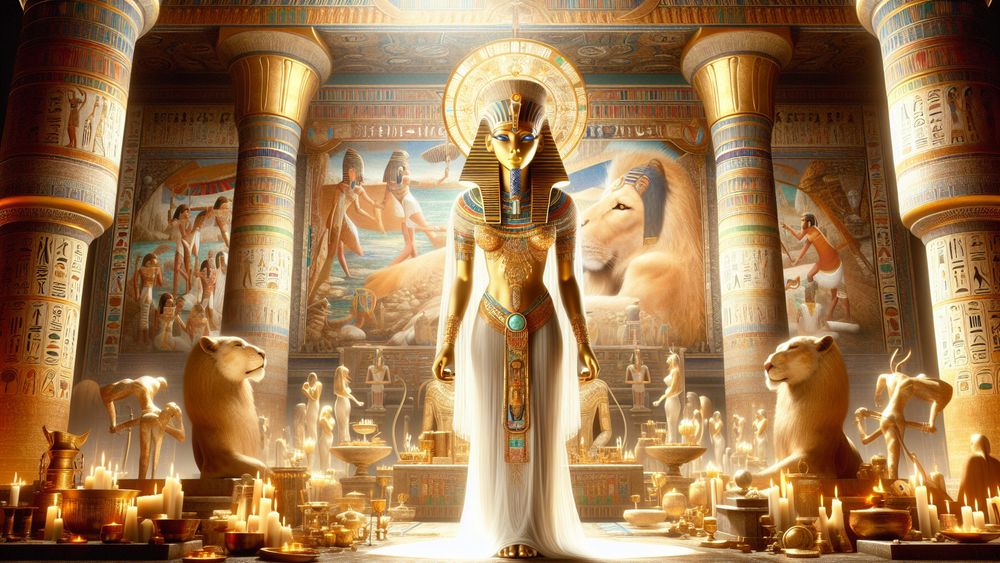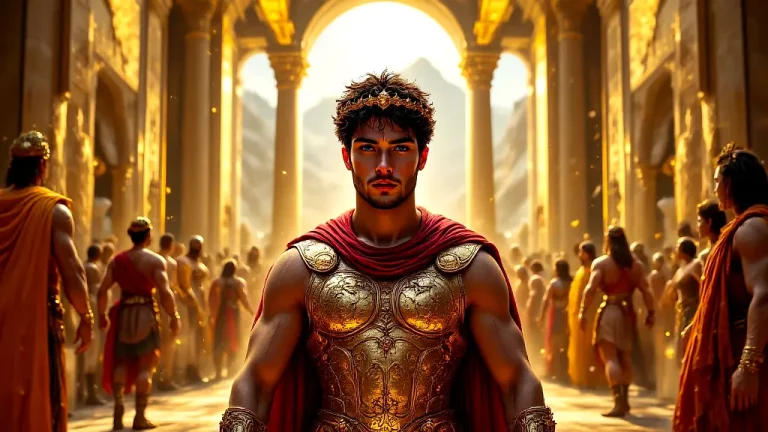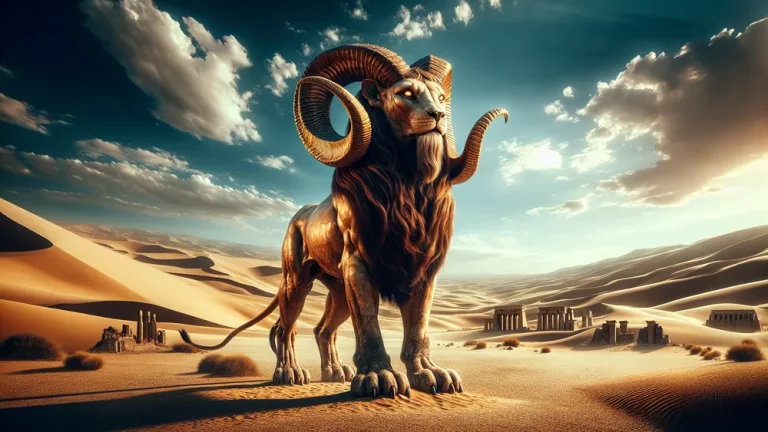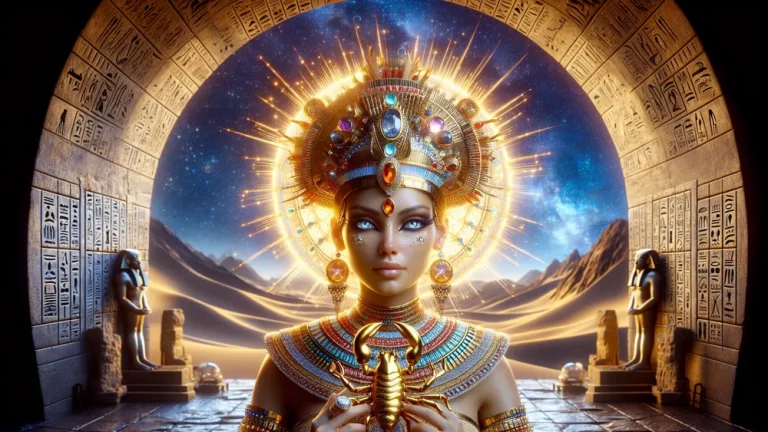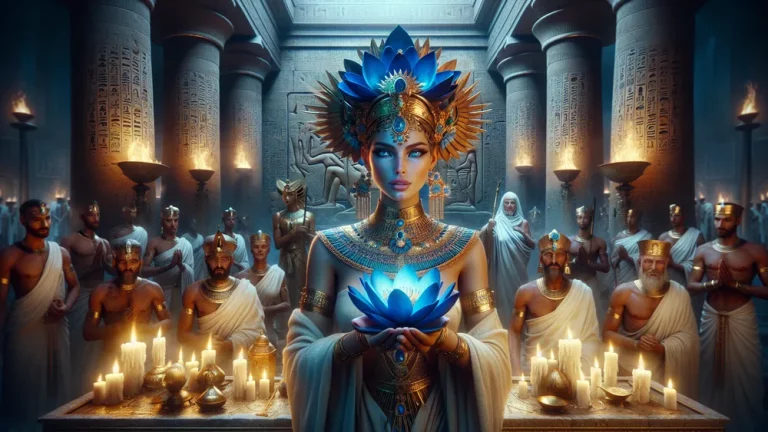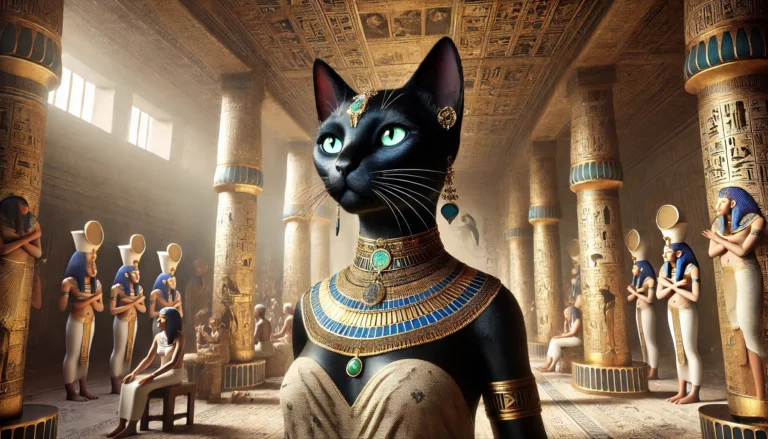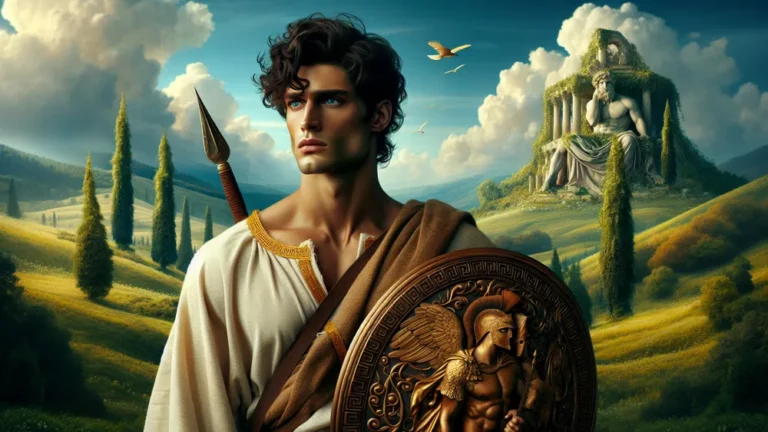Nun: Creator God And Symbol Of Chaos In Ancient Egypt
In the world of ancient Egyptian beliefs, Nun is a standout. Picture this: before anything else, there’s Nun. It’s like the deepest ocean but without any shores. This isn’t your average god with an animal head or a mighty power over something we see and touch every day. No, Nun is all about the before times.
Key Points:
- Nun in ancient Egypt symbolizes chaos and creation before all else.
- Nun is the essence of creation and disorder, foundational to Egyptian beliefs.
- Nun is represented as endless waters and plays a vital role in the creation of the world and the afterlife.
- Egyptian art and writings showcase Nun as dark, endless waters and a key figure in cosmology.
- Nun influenced Egyptian society and religious rituals, though specific temples for Nun are absent.
- Comparisons with other mythologies show similarities in the concept of chaos and water as the origins of creation.
- Nun’s role in the creation story is central, as the first god emerged from Nun’s watery abyss.
The before everything. It’s chaos but in a way that’s hard to wrap your head around because it’s so… empty and full at the same time. The stories that wrap around Nun are key if you really want to get how the folks back then saw the world popping into existence. They didn’t think of a bang and everything starting. They saw an endless sea that suddenly decided it was showtime for the universe.
Diving into texts and ancient art, we get to piece together this puzzle. Nun isn’t about being flashy; it’s about being absolutely foundational to everything that comes after in the tales and beliefs that have colored one of the most intriguing civilizations we’ve ever come across.
The Origins and Mythology of Nun
Diving into the heart of ancient Egyptian beliefs, we find Nun.
Who is Nun in Ancient Egyptian Mythology?
In the heart of ancient Egyptian tales, Nun is like the endless sea before the dawn of time. Picture this: before anything else, there was Nun, a massive ocean of chaos and nothingness. It’s where everything begins. From this watery silence, the very first god decides to show up and kick-start the universe and its divine crew. Nun isn’t your typical god though.
It doesn’t walk and talk or throw lightning bolts. Yet, it’s everywhere, holding up the world and keeping the cosmic order in check.
- Nun is limitless and boundless, which really hammers home how eternal and infinite it is.
- The story where the first god springs from Nun changes a bit depending on who you ask, but the gist is always the same: Nun is where it all starts.
- Even though Nun kind of stays in the background, its vibe is crucial for keeping everything going smoothly in the cosmos.
So, while Nun may seem like it’s simply floating around in the background, its role is absolutely vital. It’s like the stage for all of Egyptian mythology’s wild stories and gods. Without Nun, there’s no setting for these tales to unfurl. It’s that essential piece of the puzzle that makes everything else make sense.
Nun may appear in the background, but its presence is crucial for the smooth running of the cosmos and the foundation for all Egyptian mythology.
Symbols and Representations of Nun
When you look into how the ancient Egyptians showed Nun in their art and writings, it’s like opening a book that’s all about the very start of everything. Water plays a huge part here. It’s often shown as this endless, dark sea that wraps around the world or sits beneath the very first piece of land that ever was.
This isn’t simply about water being water. It’s way bigger. It’s about the mess and wildness before everything began and how that very chaos had the power to kickstart life. Then, there are these images of boats, sailing across what seems like an endless night. These aren’t any ordinary boats.
They’re solar boats, and they’re all about the sun’s trip through the dark every night, coming back to us every morning, fresh and new. So when you see these boats in ancient carvings or paintings, think about them as symbols of hope and renewal.
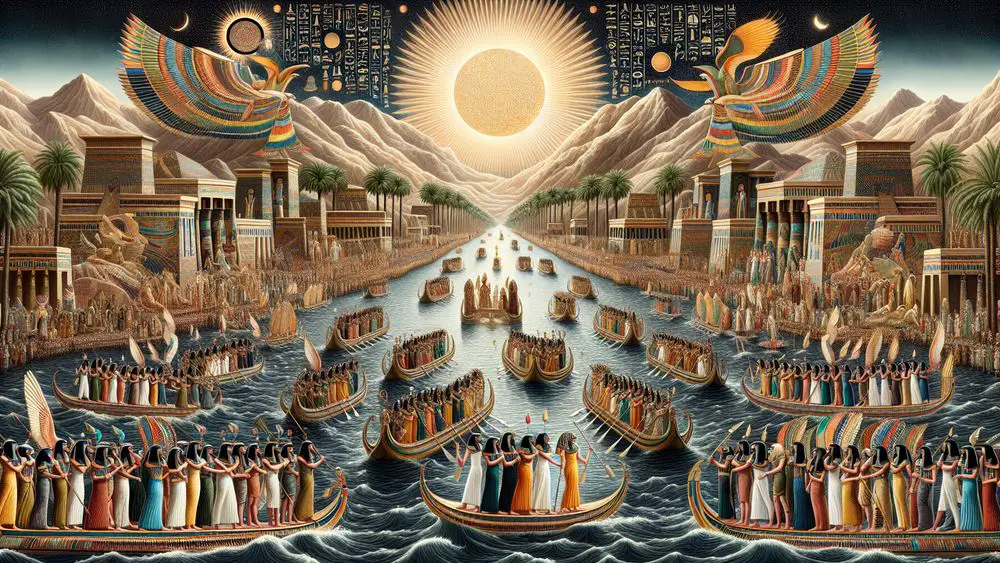
So, when we talk about Nun and how the Egyptians saw it, we’re really getting into:
- Water imagery that’s all about chaos and the start of everything.
- Dark, endless waters that show up around the world or under that first bit of land.
- Solar boats that tell a story of night turning into day, over and over.
Nun and the Creation of the World
So, we’ve been talking about Nun and all that it means. Now, let’s take a sharp turn and jump into something super interesting: how everything began.
The Story of Creation from the Waters of Nun
So, we start with Nun, which is basically everything and nothing, all at once. Imagine endless waters that stretch into forever, dark and quiet. Then, out of nowhere, the very first god decides to show up. Depending on which story you hear, this might be Atum or Ra.
This god didn’t need anyone’s help to come into being; it simply popped out of Nun or climbed atop a mound that appeared out of the water. This moment is huge because it’s when everything starts to make sense and take form. From this point, the world and all the gods begin to emerge.
First comes Shu, which is the air, and Tefnut, which means moisture. These two then lead to more gods and eventually, the whole world as we know it. Now, if we look around, lots of cultures have their own take on how everything began. They all start with some kind of chaos or nothingness, which then turns into the world and life.
For example, in stories from Mesopotamia, there’s a sea that kicks off the creation saga, while Greek tales start with chaos before moving on to the birth of Earth and other entities. While each story has its own flavor and characters, they all share this idea that before anything else, there was chaos or a void.
And very often, water plays a key role in bringing life and order out of this chaos.
- A primordial mound and endless waters are where it all starts for the Egyptians.
- Atum making Shu and Tefnut is quite the tale, involving sneezes and spit.
- Geb and Nut get separated by Shu, which literally makes room for the world.
- While water and chaos are central in Egyptian and Mesopotamian stories, Greek myths kick off with a somewhat abstract chaos before getting to the tangible bits of creation.
The creation stories of different cultures often begin with chaos or nothingness before the emergence of life and order, with water playing a crucial role in this process.
Nun’s Role in the Underworld and Afterlife
In the heart of ancient Egyptian beliefs, Nun plays a key role. It’s all about the afterlife and the underworld for them. Imagine a world where the waters of Nun wrap around everything that’s dark and mysterious. These waters are more than what meets the eye.
They’re a mix of chaos and calm, acting as a shield and a doorway for souls heading to what comes next. When someone dies, they believe this person has to cross these waters. It’s no small feat. This trip is like going back to the very start, before anything existed at all. The waters of Nun are where everything begins and ends.
They link life and death, making a full circle. This idea that after we leave this world, we go through Nun’s waters to reach a new kind of existence is pretty powerful. It ties everything together, making Nun forever present in the cycle of life and afterlife.
The Cultural and Religious Significance of Nun
So, we’ve been talking about Nun and all that jazz. Now, let’s switch gears and get into how this ancient figure really left a mark on Egyptian society and religious rituals.
Worship and Veneration of Nun
When it comes to honoring Nun, the scene is a bit different. Not so much in the spotlight with grand temples or flashy rituals. Yet, this doesn’t make Nun any less key to the ancient Egyptians. Think of Nun as the quiet force behind the scenes, especially during the early days in Heliopolis.
Here, Nun was a major player in the creation story, setting the stage for gods and goddesses that came after. While we may lack the details on specific ceremonies, it’s clear that Nun’s essence seep into many aspects of religious life. This includes those moments that touch on life’s beginnings and endings, which Nun’s endless waters reflect so well.
Priests probably gave Nun a nod in their daily spiritual duties, especially when dealing with themes of creation and rebirth. While temples for Nun are hard to pin down, his presence weaved through Egyptian beliefs and practices, making him an unseen but ever-present force.
| Period | Location | Significance |
|---|---|---|
| When it all began | Heliopolis | Nun’s part of the Ogdoad really set the tone for religious thought that followed. |
| A bit later on | All over Egypt | Even if direct worship isn’t clear, Nun’s vibes are all over writings and tomb inscriptions. |
| The peak times | Thebes and Nubia | Temples may be shy, but texts give Nun plenty of shoutouts, blending his worship into daily religious life. |

Nun’s Influence on Egyptian Society and Culture
In Egypt, long ago, Nun’s story really sticks with people. It’s all about water and chaos before everything else. Artists and writers loved to sprinkle this idea everywhere. You see, they put water scenes and chaotic vibes in tombs and temples. It’s like they’re saying, “Hey, this is where it all began.” And it wasn’t random.
They did it to show respect for the gods that came from Nun. This was their way of keeping the story alive. Even today, that old tale finds its way into books and movies. It’s like Nun never really left. People still get inspired and use those ancient themes to talk about how everything started and the circle of life and death.
It’s simple yet so powerful. Everyone gets it, and it keeps the conversation going about what the Egyptians thought about life, the universe, and everything in between.

The tale of Nun and the water and chaos theme in ancient Egyptian art and writing remains a powerful and timeless source of inspiration for discussions on the origins of life and the universe.
Comparisons and Connections
So, we’ve taken a good look at Nun, digging into the heart of ancient Egyptian beliefs and stories. Now, let’s shift gears. We’re heading into a space where Nun meets other gods from far and wide. It’s a bit like finding common threads and unique bits in tales that span the globe.
Nun and Similar Deities in World Mythologies
When we talk about Nun and its buddies from other cultures, it’s like opening a book that tells one story in a thousand ways. Greek mythology has Chaos, which is pretty much a cousin to Nun, hanging out in the nothingness before everything kicks off.
Then there’s the Hindu story, where Vishnu chills on a cosmic ocean, which sounds a lot like Nun’s endless waters where creation bubbles up. It’s wild how so many stories from around the globe share this vibe of water and chaos being the starting line for everything.
So, when we look at other mythologies, it’s clear that water and a bit of a mess before order aren’t unique to the Egyptians. The Norse have Ginnungagap, which is their version of a giant, empty space where the world gets going. And don’t get me started on the Sumerians and Babylonians.
They’ve got Abzu and Tiamat, who are all about that water and chaos life, playing a huge part in their creation tales. It’s like everywhere you look, people knew that water wasn’t just for swimming and chaos wasn’t just for making a mess. They were the ingredients for making everything we know.
- Greek mythology’s Chaos parallels Nun’s role as a pre-creation void.
- Hindu mythology features a cosmic ocean similar to Nun’s watery abyss.
- Norse mythology’s Ginnungagap serves as a formless expanse before creation.
- Sumerian and Babylonian myths include deities Abzu and Tiamat, representing water and chaos.
Pantheon of All the Egyptian Mythology Gods
So, when we talk about Egyptian mythology, each one of these deities has a job to do. Some are all about creating the world, while others focus on keeping folks safe, making sure crops grow, or guiding people after they die. It’s a busy crowd.
FAQs
1. Who created Nun in Egyptian mythology?
So, when we talk about where Nun comes from, it’s like heading into a story where the start is as mysterious as the depths of the ocean. Nun simply was. Before anything else got its start, before there was a before, Nun’s there. It’s all about those endless waters and chaos that didn’t need anyone to bring them into being.
2. How did Nun influence the creation of the world?
In the very beginning, Nun’s waters held everything that would ever be. From this watery silence, the very first god popped up. Imagine that! It’s like the whole world and everyone in it started from a single point in a massive, endless ocean. This moment, when the first god came out of Nun, it was when everything went from being a chaotic soup to something more ordered and structured.
3. Are there any temples dedicated to Nun in Egypt?
When you think about temples for Nun in Egypt, it’s a bit of a tricky question. No specific temples for Nun exist, which might seem odd at first. Nun is this huge concept, after all. He’s all about the endless, chaotic waters that were around before anything else. But that’s the thing.
4. How is Nun represented in Egyptian art and hieroglyphs?
When you look at Egyptian art and hieroglyphs, you spot Nun easily. He often appears as dark waters that seem to go on forever. Sometimes, you see him as a man. This man isn’t doing anything ordinary. He carries a bark or a jug of water. This way of showcasing Nun ties him directly to the endless waters that were there before anything else.

